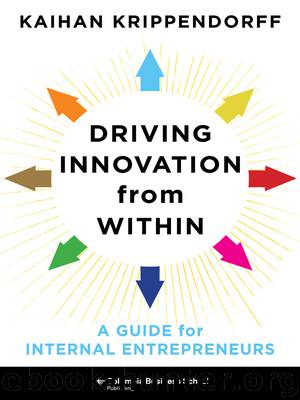Driving Innovation from Within by Kaihan Krippendorff

Author:Kaihan Krippendorff
Language: eng
Format: epub
Tags: BUS041000, Business & Economics/Management, BUS025000, Business & Economics/Entrepreneurship
Publisher: Columbia University Press
Published: 2019-10-07T16:00:00+00:00
Step Four: Observe and Gather Data
The next step is to get out of the office and put what you have built (your storyboard, MVP, or beta) in front of your key stakeholders: users, internal stakeholders, external partners, people who influence the buying process, or anyone else whose input you need to complete the test you designed in step three.
A manufacturer of custom picture frames, for example, had the idea of creating a kiosk for framing shops in which customers could see how their artwork would look in different types of frames. Two stakeholders were critical: users (people who buy picture frames) and the owners of the framing shops. Even though they had the kiosk and the software already built, they recognized that simply installing kiosks in stores would be unnecessarily costly. Instead, they could create a mock-up, show it to frame-shop owners at a conference they were organizing, and get their feedback. They asked questions like “What would this kiosk have to do for you to adopt it?” or “What are your concerns about putting this kiosk in your store?” A similar low-cost experiment with users would give them a much better idea what the adoption rate might be and what price they might be able to charge.
The goal is to learn as quickly and inexpensively as possible.
Talk to prospective customers with your storyboard or MVP in hand. Ask them to describe the need they would want to address with your solution. Ask them to outline when and where and why this need arises for them. Have them walk you through how and where they search for potential solutions. Ask them on what basis they compare their solution options and how they ultimately choose to purchase one, or (as is often the case) why they choose to do nothing.
Is this kind of interviewing new to you? Here’s a technique you might find helpful. Pretend you are writing a play, and this will be a key scene. The scene opens with your prospective buyer talking to a colleague about a concern they both recognize. They brainstorm a couple of solutions, and eventually your name comes up. The buyer asks you to come in and chat. Now imagine, as lifelike as possible, how that conversation would go. What would you want to learn, and what might happen next?
In later cycles, as you develop your solution further, you will probably want to come up with other “discover” stories. But for now, pick one that seems, based on your interviews, the most common. Really get into that story and understand the full context of what’s happening with your customer: the psychology, the feelings, the circumstances.
It’s also very valuable to learn how your customers react after they purchase your concept. Think of this as describing the story of them using your product or service.
Several models and experts suggest that the two most important parts of this story are the beginning and the end—the state they are in when they buy, and the state they are in when they have met their need.
Download
This site does not store any files on its server. We only index and link to content provided by other sites. Please contact the content providers to delete copyright contents if any and email us, we'll remove relevant links or contents immediately.
Bad Blood by John Carreyrou(6558)
Rich Dad Poor Dad by Robert T. Kiyosaki(6414)
Principles: Life and Work by Ray Dalio(6226)
Playing to Win_ How Strategy Really Works by A.G. Lafley & Roger L. Martin(5937)
Management Strategies for the Cloud Revolution: How Cloud Computing Is Transforming Business and Why You Can't Afford to Be Left Behind by Charles Babcock(4528)
The Confidence Code by Katty Kay(4190)
Thinking in Bets by Annie Duke(4154)
American Kingpin by Nick Bilton(3760)
Delivering Happiness by Tony Hsieh(3369)
Project Animal Farm: An Accidental Journey into the Secret World of Farming and the Truth About Our Food by Sonia Faruqi(3178)
The Power of Habit by Charles Duhigg(3063)
The Tyranny of Metrics by Jerry Z. Muller(3005)
Brotopia by Emily Chang(3002)
Mastering Bitcoin: Programming the Open Blockchain by Andreas M. Antonopoulos(2983)
The Marketing Plan Handbook: Develop Big-Picture Marketing Plans for Pennies on the Dollar by Robert W. Bly(2978)
I Live in the Future & Here's How It Works by Nick Bilton(2938)
The Content Trap by Bharat Anand(2863)
Building a StoryBrand by Donald Miller(2843)
Applied Empathy by Michael Ventura(2839)
